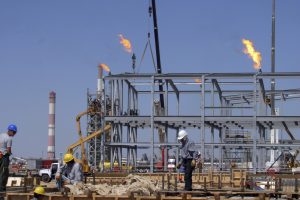This week the number of coronavirus cases traced specifically to workers at the Tengiz oil field in western Kazakhstan crested 1,000. The Atyrau region, in which the Tengiz field is located, is has registered the third largest number of cases (1,175 as of June 4) after Kazakhstan’s two largest cities — financial hub, Almaty (2,741), and the capital, Nur-Sultan (2,344).
Even as Kazakhstan, broadly, has begun to move out from under the harshest pandemic restrictions, Tengiz remains a worrying hotspot.
The Tengiz oil field and its pandemic pains epitomizes the risks Kazakhstan faces, both economic and social. As the pandemic slowed economic activity and travel around the globe in the first half of 2020, it exerted downward pressure on oil prices. Prices fell with demand. Given that (based on 2018 data) crude petroleum led among Kazakhstan’s exports — at 59.8 percent — the tumble in prices and demand invariably will send shockwaves through the Kazakh economy.
Tengiz is believed to be the sixth largest oil field in the world with an estimated 25 billion barrels of oil in place originally. Including the Korolev field, which is included in the same project licensing area, Tengiz is estimated to have between 6 and 9 billion barrels of recoverable crude oil reserves. The site is at present operated by Tengizchevroil, a joint venture between U.S. oil giants Chevron (50 percent share) and ExxonMobil (25 percent), Kazakhstan’s state-owned oil and gas company KazMunayGas (20 percent) and LukArco, a subsidiary of Russia’s Lukoil (5 percent).
Kazakhstan, as of late April, was reportedly nearing a deal with the international partners operating its major oil fields to cut output by 22 percent in order to meet commitments Nur-Sultan made along with the world’s major oil producers in an attempt to rescue the price for all.
A month later, in late May, Chevron announced it would send most of the workers at Tengiz home. According to a Bloomberg report, Chevron executives told a virtual version of their annual shareholder meeting that, nearly 20,000 workers were sent home — two-thirds of the workforce at the remote site. The workers, Chief Executive Officer Mike Wirth reportedly told investors, were tested for the virus as they departed. That leaves around 10,000 workers still at the site.
Bruce Pannier wrote a simple truth yesterday: “The price of oil might be low, but Kazakhstan has no choice but to keep pumping it out.”
But beyond the basic economic matters are the social implications. Not only is the continued growth in cases at the Tengiz field worrisome for public health reasons, but Kazakhstan’s oil workers have historically been at the tip of public protests and oil fields sites of occasional strikes and protests. The effective ban on independent trade unions, which Paolo Sorbello highlighted last summer when unpacking a strike and massive brawl at Tengiz, allows dissatisfaction regarding labor disputes to seethe, and sometimes bubble over. It’s hard to imagine the dismissal of two-thirds of the field’s workforce, at a time of complete economic and employment crisis, not inflaming extant frustrations. And the rise in coronavirus cases at the field will only worsen the situation.

































